Related Research Articles

Pope Callixtus I, also called Callistus I, was the bishop of Rome from c. 218 to his death c. 222 or 223. He lived during the reigns of the Roman emperors Elagabalus and Alexander Severus. Eusebius and the Liberian catalogue list his episcopate as having lasted five years (217–222). In 217, when Callixtus followed Zephyrinus as Bishop of Rome, he started to admit into the Church converts from sects or schisms. He was killed for being Christian and is venerated as a saint by the Catholic Church.
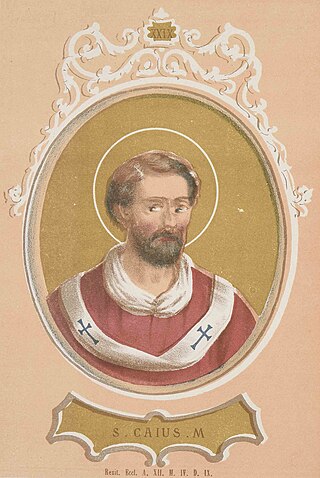
Pope Caius, also called Gaius, was the bishop of Rome from 17 December 283 to his death in 296. Little information on Caius is available except that given by the Liber Pontificalis, which relies on a legendary account of the martyrdom of Susanna of Rome for its information. According to legend, Caius baptized the men and women who had been converted by Tiburtius and Castulus. His legend states that Caius took refuge in the catacombs of Rome and died a martyr.

Saint Valentine was a 3rd-century Roman saint, commemorated in Western Christianity on February 14 and in Eastern Orthodoxy on July 6. From the High Middle Ages, his feast day has been associated with a tradition of courtly love. He is also a patron saint of Terni, epilepsy and beekeepers. Saint Valentine was a clergyman – either a priest or a bishop – in the Roman Empire who ministered to persecuted Christians. He was martyred and his body buried on the Via Flaminia on February 14, which has been observed as the Feast of Saint Valentine since at least the eighth century.

Saint Lawrence or Laurence was one of the seven deacons of the city of Rome under Pope Sixtus II who were martyred in the persecution of the Christians that the Roman emperor Valerian ordered in 258.
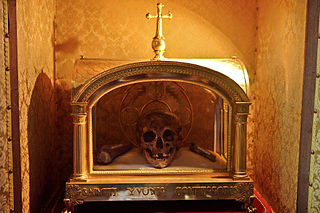
In religion, a relic is an object or article of religious significance from the past. It usually consists of the physical remains or personal effects of a saint or other person preserved for the purpose of veneration as a tangible memorial. Relics are an important aspect of some forms of Buddhism, Christianity, Islam, shamanism, and many other religions. Relic derives from the Latin reliquiae, meaning "remains", and a form of the Latin verb relinquere, to "leave behind, or abandon". A reliquary is a shrine that houses one or more religious relics.

Agathaof Sicily is a Christian saint. Her feast is on 5 February. Agatha was born in Catania, part of the Roman Province of Sicily, and was martyred c. 251. She is one of several virgin martyrs who are commemorated by name in the Canon of the Mass.
Cyriacus, sometimes Anglicized as Cyriac, according to Christian tradition, is a Christian martyr who was killed in the Diocletianic Persecution. He is one of twenty-seven saints, most of them martyrs, who bear this name, of whom only seven are honoured by a specific mention of their names in the Roman Martyrology.
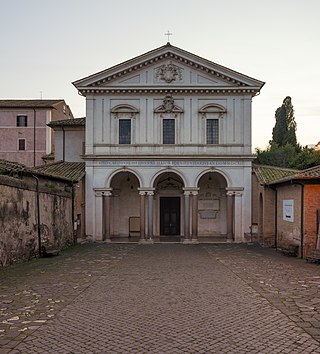
San Sebastiano fuori le mura, or San Sebastiano ad Catacumbas, is a minor basilica in Rome, Central Italy. Up to the Great Jubilee of 2000, San Sebastiano was one of the Seven Pilgrim Churches of Rome, and many pilgrims still favour the traditional list.

The Basilica of Saint Sylvester the First, also known as, is a Roman Catholic minor basilica and titular church in Rome dedicated to Pope Sylvester I. It is located on the Piazza San Silvestro, at the corner of Via del Gambero and the Via della Mercede, and stands adjacent to the central Post Office.
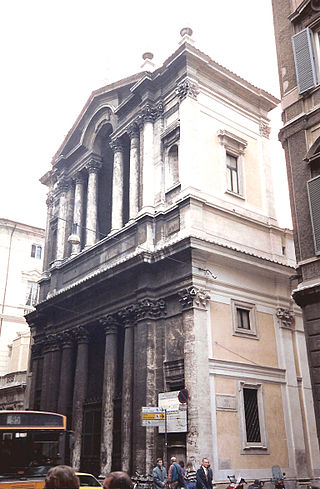
Santa Maria in Via Lata is a church on the Via del Corso, in Rome, Italy. It stands diagonal from the church of San Marcello al Corso. It is the stational church for Tuesday in the fifth week of lent.

Saints Marcellinus and Peter are venerated within the Catholic Church as martyrs who were beheaded. Hagiographies place them in 4th century Rome. They are generally represented as men in middle age, with tonsures and palms of martyrdom; sometimes they hold a crown each.
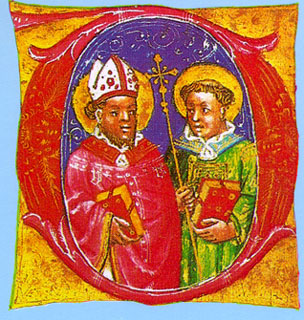
Hermagoras of Aquileia is considered the first bishop of Aquileia, northern Italy. Christian tradition states that he was chosen by Mark to serve as the leader of the nascent Christian community in Aquileia, and that he was consecrated bishop by Peter. Hermagoras and his deacon Fortunatus evangelized the area but were eventually arrested by Sebastius, a representative of Nero. They were tortured and beheaded.

Saint Calepodius was a priest who was killed during the persecutions of Christians by the Roman Emperor Alexander Severus. One of the catacombs of Rome, the cemetery of Calepodius on the Aurelian Way, was named after him.
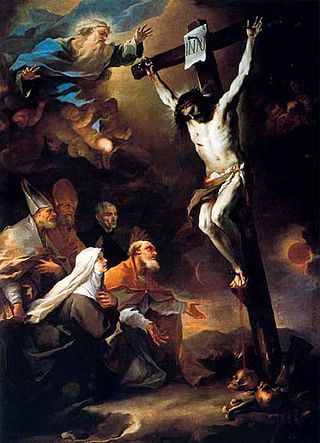
Aspren or Asprenas was a 1st-century Christian saint and venerated as the first Bishop of Naples.

Saint Severus was a bishop of Naples during the 4th and 5th centuries. He is considered the eleventh legitimate Catholic bishop of Naples, and the twelfth overall, succeeding Maximus. His episcopate ran from February 363 to April 29, 409, the traditional date of his death. Between the episcopates of Maximus and Severus, Zosimus, an Arian was established as Bishop, who was condemned as heretical by the Catholic Church.

Saint Fortunatus was a 6th-century bishop of Todi. According to tradition, he defended Todi during a Gothic siege. He is the patron saint of Todi.

Saint Fortunatus of Spoleto was a parish priest near Spoleto in Umbria sometime between the 4th and 5th centuries. He is venerated as a saint within the Catholic Church.

Eleutherius, also written as Eleutherus, Eleuterus and Eleftherios; sometimes called Liberalis or Liberator Greek: Ἐλευθέριος) and his mother Antia, or Anthia are venerated as Christian saints and martyrs in Greece and Italy.
San Ciriaco de Camiliano was an ancient church of the city of Rome, formerly located on the present site of the Piazza del Collegio Romano near the Via del Corso. It was demolished in 1491 during construction on the church of Santa Maria in Via Lata.
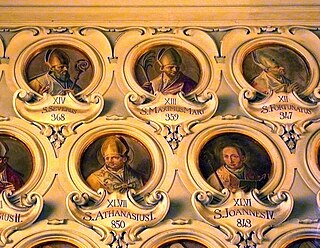
Fortunatus of Naples was a 4th-century Christian bishop. He is the first historically-attested bishop of Naples, as one of the recipients of a letter written by those who took part in the Arian Council of Philippopolis in the 340s - his tradition states he was a fierce opponent of Arianism. His term as bishop is traditionally held to be 347 to 359.
References
- 1 2 3 4 5 6 San Fortunato di Casei
- 1 2 3 La Legione Tebea
- 1 2 San Fortunato Pantelleria Archived May 5, 2009, at the Wayback Machine